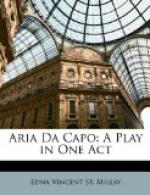COTHURNUS: Plain toga of dull purple in some heavy, unreflecting material which will fall into large folds, lined with sombre flame-color; a garment with large purple sleeves, of which only the sleeves were visible, was worn under the toga,—but the effect should be classical; heavy boots should be worn, as nearly as possible like the tragic Roman buskin; one end of the great toga is tied into a rough hood which covers the actor’s head; a mask may be worn, but it is often difficult to speak through, and, if desired, the actor’s face may be made up to represent a mask of Tragedy.
THYRSIS and CORYDON: These costumes, in striking contrast to the elegance of those of Pierrot and Columbine, should be very simple, and very roughly made; short tunics of outing-flannel or some such material— fastened loosely over one shoulder,—one shoulder, as well as most of the back and breast, exposed. Legs bare, or swathed from the knee to the ankle in rough strips of the same material. Sandals. Cloaks of heavier, cheap material fastened to the tunics in such a way that they will appear to be simply flung over the shoulder, but actually fastened very cleverly in order to avoid tripping the shepherds, who are continually sitting down on the floor and getting up again.
Thyrsis wears a dark grey tunic and cloak of raw bright red,—but not a turkey-red, as this color will kill the blue of Corydon’s cloak. Corydon wears tunic of light grey and cloak of brilliant blue. There must be no red or blue used anywhere in the entire play excepting in the blue and red of these two cloaks. The two shepherds must be so strong and vivid in every way that when Columbine comes in and says, “Is this my scene or not?” it will seem to the audience that it is she, not the shepherds, who is hopelessly out of the scene.
CHARACTERS:
PIERROT: Pierrot sees clearly into existing evils and is rendered gaily cynical by them; he is both too indolent and too indifferent to do anything about it. Yet in several lines of the play his actual unhappiness is seen, —for instance, “Moon’s just a word to swear by,” in which he expresses his conviction that all beauty and romance are fled from the world. At the end of the play the line, “Yes, and yet I dare say he is just as dead,” must not be said flippantly or cynically, but slowly and with much philosophic concentration on the thought. From the moment when Columbine cries, “What’s that there under the table?” until Pierrot calls, “Cothurnus, come drag these bodies out of here!” they both stand staring at the two bodies, without moving in any way, or even lifting their eyes. (This same holding of the play is used several times also by the shepherds,—for instance, always during the off-stage interpolations, they stand either staring at each other across the wall, or maintaining whatever other position they may have had when the off-stage voice begins speaking, until the interruption is over, when they resume their drama quite as if




